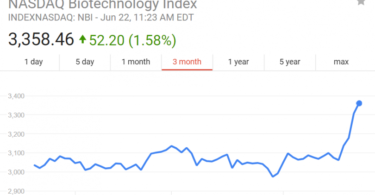When Amazon (NASDAQ:AMZN) bought Whole Foods Market about a year ago, the major grocery chains shuttered in disbelief and their stocks retreated. After all, when AMZN sets its sights on you, the results are usually not too good.
And over the last year or so, many grocery chains have had to fight hard to keep their sales growing as their margins continue to collapse.
But it turns out that Amazon isn’t done hitting the grocery store chains where it hurts. In fact, it plans to squeeze them a bit more.
Rumors and news have begun to swirl that Amazon is working not only on opening more physical grocery stores to serve as delivery bases, but that it’s also working hard on entering one of the most profitable niches for grocery stores: health and beauty products.
That’s another example of how AMZN plans to dominate all the parts of the retail landscape. For the grocery stocks, it’s another cautionary tale.
Whole Foods Was a Big Win for AMZN Stock
To realize how big of a threat that Amazon has become to the grocery players, just take a look at Kroger’s (NYSE:KR) latest results. It spent a great deal of money to compete with AMZN on delivery and technology, badly hurting its overall fourth-quarter earnings. The problem for KR and other major grocery chains is that AMZN isn’t done yet.
Amazon’s acquisition of Whole Foods turned out to be ingenious. For one thing, the deal has expanded Amazon’s presence and delivery capabilities. There are roughly 479 Whole Foods stores that now can serve as warehouses for the same-day or next-day delivery of products. These stores are a major component of AMZN’s Prime Pantry delivery service.
And speaking of Prime, Whole Foods has provided another important advantage to Amazon: it’s gotten more people to sign up for the company’s Prime service. By offering some discounts at “Whole Paycheck” for Prime members, AMZN has made Prime more enticing. That’s important, since once consumers are in the retailer’s ecosystem, they purchase more goods from it. The average Prime member spends roughly $1,400 per year on Amazon. Customers who aren’t Prime members only spend an average of $600 per year.
Amazon Ups Its Grocery Game
The problem for Amazon is that Whole Foods only accounts for 2.5% of the total U.S. grocery market. And generally, it caters to a smaller and wealthier segment of the population than rivals like Walmart (NYSE:WMT) or Kroger.
Naturally, Jeff Bezos isn’t going to let that situation continue. AMZN is going to fight back.
A new report in the Wall Street Journal shows that Amazon is planning to open a new chain of grocery stores that are different from Whole Foods.
AMZN has already signed several leases for such stores in cities like Chicago, San Francisco, and Seattle. The stores won’t be designed to compete with the upscale, organic-focused Whole Foods at all. The stores’ product mix would be similar to that of a normal grocery store and feature a variety of products at low price points. Are you looking to find free-range Himalayan salt? Head to Whole Foods. Do you want to buy Doritos? Amazon’s new store will have it.
And AMZN has the ability to easily build up these operations. According to the Wall Street Journal, Amazon is targeting areas that have recently been built up and occupied stores with leases that are ending soon.
So its new stores will be located in a variety of suburban strip malls, open-air shopping centers or even in malls where Sears stores used to be.
Moreover, the report mentioned that these new stores will be about 35,000 square- feet – or about half the size of a typical grocery store – and use AMZN’s data mining to determine the best product mix for the local market.
Amazon’s initiative will tremendously undermine the size and location competitive advantages that Kroger and other supermarket chains have in the grocery game.
AMZN Ups Its Grocery Game AGAIN!
But it turns out that Bezos is doing even more to advance Amazon’s plans in the grocery space. The second part of the Journal’s report stated that AMZN is looking to be flexible about what it can sell in these new locations. Sometimes leases prevent stores from competing with other retailers at the same strip mall or shopping plaza. But Amazon will not accept any such restrictions.
According to sources quoted by The Journal, that’s because AMZN is looking to have some of these stores focus on health and beauty items. Cosmetics and skin- and hair-care products carry very high margins and are the real profit drivers for grocery chains.
In a previous column, I highlighted Amazon’s ambitions in private-label products and the juicy margins that such products carry. Health and personal-care items are the best-selling category for AMZN online. Analysts at the research firm Ascential estimate that AMZN generates $5 billion of annual sales from such products. Amazon’s new stores will both enhance its logistics operation, just like Whole Foods’ stores have, and enable it to get more of those high-margin products into consumers’ hands.







